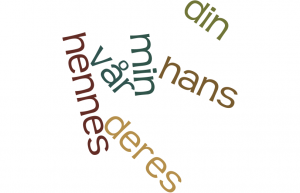 When you want to say ”your” or ”my” something, there are really three things to consider in Norwegian:
When you want to say ”your” or ”my” something, there are really three things to consider in Norwegian:
1. Before or after?
In Norwegian, a possessive pronoun (”our”, ”their”…) may be placed either before or after a noun: Det er min dag i dag! (”It’s my day today” = It’s my lucky day) vs. Har du sett iPad-en min? (Have you seen my iPad?)
So, how to choose? I’d say: Put ’em at the end! 🙂 Expressions such as vårt land, hans bil (our country, his car) often feel a bit old-fashioned or formal. Of course, it depends on the region you’re in. In most spoken Norwegian, however, speakers naturally opt for landet vårt, bilen hans. As you’ve probably noticed, the ”the form” of the noun is used in this context (”the-country our”, ”the-car his”). The up-front version, though, is still common in many expressions and in poetic language: Din tanke er fri (”Thy thought is free” – a song title).
2. Does it go with a plural, or an ”et”, ”en” or ”ei” noun?
If the possessive pronoun ends in an -s, you’re lucky – it doesn’t change at all: katten – bikkja – huset – barna hans/hennes/deres (his/her/their cat – dog – house – children). (”Bikkje” is another and quite everyday-ish word for hund.)
The other ones, however, have different forms: katten min/din/vår – bikkja di/mi/vår – huset mitt/ditt/vårt – barna mine/dine/våre (my/your/our cat – dog – house – children).
Unlike English, these little words don’t change when they’re on their own: the girl is mine = jenta er mi. (Sorry, I couldn’t resist dropping a pop reference!)
3. Does it refer to someone else?
This is the tricky part… Take the phrases Hun ødelegger boka hennes (She’s destroying her book), Han tar hatten hans (He’s taking his hat), De spiser eplene deres (They’re eating their apples). In each instance, the thing destroyed or taken or eaten belongs to someone else than the persons who are active. If they destroyed or took or ate their own things, the phrases would look like this:
Hun ødelegger boka si.
Han tar hatten sin.
De spiser eplene sine.
The neuter form is sitt: De sitter i treet sitt. (They’re sitting in their tree – and not in someone else’s.) This is a grammatical nicety that doesn’t exist in English, so stay alert when you read or listen to Norwegian! 🙂






Comments:
Jan:
I have a question about double object constructions, if there exist any. Which form do I use if I want to translate an English sentence like “Peter brought Anna her car”?, with “her” referring to “Anna”. Do I use the “somebody else’s” form or the other one?
Thanks in advance!!!
Bjørn A. Bojesen:
@Jan @Hei Jan, you’d use the other form! 🙂 ”Peter brakte Anna bilen hennes” to paraphrase directly (a Norwegian would probably use some other words, like hente, fetch, instead of bring…) ”bilen sin” would refer back to Peter, i.e., ”his car”. You’re welcome in retrospect! 🙂